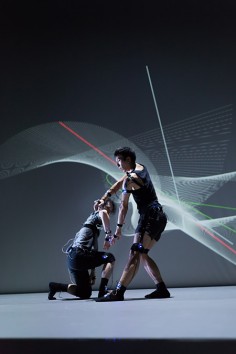YCAM InterLab + Yoko Ando
Dividual Plays
source: cinranet
YCAM InterLabと安藤洋子による新作ダンス公演『Dividual Plays―身体の無意識とシステムとの対話』が、1月24日、25日に山口・山口情報芸術センター[YCAM]スタジオAで上演される。
同公演は、インスタレーション作品やパフォーミングアーツ作品の開発などを行っている研究開発チーム「YCAM InterLab」が、安藤や国内外のソフトウェア開発者と継続的に取り組んでいる、身体の可能性を拡張するプロジェクト「Reactor for Awareness in Motion(RAM)」の成果を発表するもの。慣性式のモーションキャプチャーシステムを取り付けたダンサーの周りの環境をリアルタイムに解析し、ダンサーに動きと連動した仮想環境からのフィードバックを提示することで、ダンスのアイデアを引き出していくという。
なお、同公演では「箱庭」と呼ばれる小さな実験室に様々な装置や自然物を設置し、ダンサーの動きに連動して物理的な変化を発生させるとのこと。また、それらの変化がステージやダンサーにフィードバックされ、その後再度箱庭に返ることで、全体が大きなシステムとして連鎖するダイナミックな作品になるという。
.
.
.
.
.
.
.
source: ramycamjp
Yamaguchi Center for Arts and Media (YCAM) has played an active role in cultivating creative and research environments to support the art & technology of the next generation. Since 2011, we have carried out “Reactor for Awareness in Motion (RAM)”, a research project for developing tool for dance creation and education, with Yoko Ando, a dancer from The Forsythe Company, a leading contemporary dance company and programmers from Japan and the US. Professionals in dance and technology shared an innovative concept in dance and developed it in the form of a physical tool and workshop. It is a revolutionary project in the sense that the technology is not only for theatrical effect, but also to embody one of the very natures of dance and communicate it with the world. What we witness is a technological inquiry into the nature of dance. Customized based on the perspectives of the dancer, the digital tool writes a new chapter in the history of experience in dance and technology.
Technology gives a birth to Dance Imagine dance as a kind of interaction between dancers and their surrounding environment, instead of enacting certain choreography. The possibilities of dance become innumerable. RAM can animate the body of the dancer shown upside down, for instance, by using a digital technology which captures dancers’ movements in real time. Dancer can create a dance by changing or expanding their relationship with the space while looking at the screen. It also becomes an opportunity for dancers to reconsider their subconscious image or understanding of their own body. It is also an important mission of RAM to develop a creative platform for dance, in which programmers and artists from other fields can collaborate by designing and programing scenes that stimulate dancers’ imaginations.
Mechanism and feature Using devices such as motion capture systems or “Microsoft Kinect™”, a computer detects the movements of dancers, collects and converts various relevant information in the form of image and sound for example, and visualizes them in the context of the dancer’s body. Processing everything in real time, it allows dancers to decide their next movement, in other words create their own “rule”, based on visual, aural and haptic information.
.
.
.
.
.
.
.
source: omnifeed
Initiated by YCAM InterLab, Yoko Ando, a leading dancer from The Forsythe Company, and a group of software engineers in 2010. Since then, we have been developing the “Reactor for Awareness in Motion (RAM)” and this presentation is the result of our project that explores the possibilities of body expression through technology in the form of dance performance. RAM defines dance as something produced by the interaction between the dancer and environment rather than a predetermined choreography. Dancers take in surrounding information including other dancers’ movement and react to it according to certain rules they create.
As part of our research, we developed a system that captures the movement of dancers in real time and interfaces the information to a virtual environment which gives feedback to the dancers. With programming and capabilities design this virtual environment, the system becomes a tool for exploring the possibility of dance.
Paired with the feedback system, this piece accompanies a number of small laboratories on stage in which various objects are placed. They move and shift in accordance with the movement of the dancers. These changes are converted into sound and light and feedback to the stage atmosphere and the dancers who send another signal to the labs. It is a huge “connection machine” involving the dancers, stage and the laboratories.


